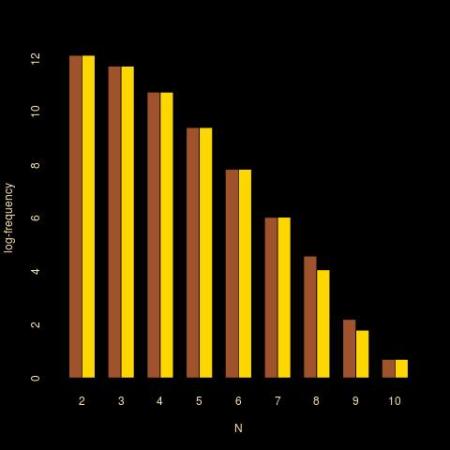Гнеде́нко and Forsythe [and e]
Want to share your content on R-bloggers? click here if you have a blog, or here if you don't.
 In the wake of my earlier post on the Monte Carlo estimation of e and e⁻¹, after a discussion with my colleague Murray Pollock (Warwick) Gnedenko’s solution, he pointed out another (early) Monte Carlo approximation called Forsythe’s method. That is detailed quite neatly in Luc Devroye’s bible, Non-uniform random variate generation (a free bible!). The idea is to run a sequence of uniform generations until the sequence goes up, i.e., until the latest uniform is larger than the previous one. The expectation of the corresponding stopping rule, N, which is the number of generations the uniform sequence went down continuously is then e, while the probability that N is odd is e⁻¹, most unexpectedly! Forsythe’s method actually aims at a much broader goal, namely simulating from any density of the form g(x) exp{-F(x)}, F taking values in (0,1). This method generalises von Neuman’s exponential generator (see Devroye, p.126) which only requires uniform generations.
In the wake of my earlier post on the Monte Carlo estimation of e and e⁻¹, after a discussion with my colleague Murray Pollock (Warwick) Gnedenko’s solution, he pointed out another (early) Monte Carlo approximation called Forsythe’s method. That is detailed quite neatly in Luc Devroye’s bible, Non-uniform random variate generation (a free bible!). The idea is to run a sequence of uniform generations until the sequence goes up, i.e., until the latest uniform is larger than the previous one. The expectation of the corresponding stopping rule, N, which is the number of generations the uniform sequence went down continuously is then e, while the probability that N is odd is e⁻¹, most unexpectedly! Forsythe’s method actually aims at a much broader goal, namely simulating from any density of the form g(x) exp{-F(x)}, F taking values in (0,1). This method generalises von Neuman’s exponential generator (see Devroye, p.126) which only requires uniform generations.
 This is absolutely identical to Gnedenko’s approach in that both events have the same 1/n! probability to occur [as pointed out by Gérard Letac in a comment on the previous entry]. (I certainly cannot say whether or not one of the authors was aware of the other’s result: Forsythe generalised von Neumann‘s method around 1972, while Gnedenko published Theory of Probability at least in 1969, but this may be the date of the English translation, I have not been able to find the reference on the Russian wikipedia page…) Running a small R experiment to compare both distributions of N, the above barplot shows that they look quite similar:
This is absolutely identical to Gnedenko’s approach in that both events have the same 1/n! probability to occur [as pointed out by Gérard Letac in a comment on the previous entry]. (I certainly cannot say whether or not one of the authors was aware of the other’s result: Forsythe generalised von Neumann‘s method around 1972, while Gnedenko published Theory of Probability at least in 1969, but this may be the date of the English translation, I have not been able to find the reference on the Russian wikipedia page…) Running a small R experiment to compare both distributions of N, the above barplot shows that they look quite similar:
n=1e6
use=runif(n)
# Gnedenko's in action:
gest=NULL
i=1
while (i<(n-100)){
sumuse=cumsum(use[i:(i+10)])
if (sumuse[11]<1])
sumuse=cumsum(use[i:(i+100)])
j=min((1:length(sumuse))[sumuse>1])
gest=c(gest,j)
i=i+j}
#Forsythe's method:
fest=NULL
i=1
while (i<(n-100)){
sumuse=c(-1,diff(use[i:(i+10)]))
if (max(sumuse)<0])
sumuse=c(-1,diff(use[i:(i+100)]))
j=min((1:length(sumuse))[sumuse>0])
fest=c(fest,j)
i=i+j}
And the execution times of both approaches [with this rudimentary R code!] are quite close.
Filed under: Books, Kids, R, Statistics, University life Tagged: Гнеде́нко, exponential distribution, George Forsythe, Gnedenko, John von Neumann, Luc Devroye, Monte Carlo Statistical Methods, Theory of Probability, uniform distribution
R-bloggers.com offers daily e-mail updates about R news and tutorials about learning R and many other topics. Click here if you're looking to post or find an R/data-science job.
Want to share your content on R-bloggers? click here if you have a blog, or here if you don't.
